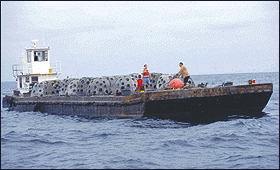
MEXICO BEACH - The sea bottom
just a few miles off the
coast here is dotted with
unusual items: car bodies,
box cars, bridge pilings.
Now "reef balls" can
be added to that list,
thanks to the newly
formed Mexico Beach
Artificial Reef Association.
Thirty of the massive concrete balls, which are
riddled with large holes, were dropped into the Gulf
last week about seven miles west of Mexico Beach.
The idea is to help create habitats that will
bring grouper, snapper, king mackerel, and other
favored fish closer to the fishermen.
"We got a heck of a lot of small boats that come
in and out of (Mexico Beach). They can't go out 30
miles," said association president Bill Cranford.
"We're trying to make something (closer) for the
fishermen and his family."
The reef balls are more dome-shaped than round,
and look more like huts than balls. They stand
about 4-feet high and weight 2,700 pounds each.
From 50 yards away, they are the flat gray of mud
dauber nests.
The reef association, which formed two months
ago, rounded up $10,000 to buy 30 reef balls from
Coastal Reef Builders of Pensacola.
The company shipped the balls by barge, and two
workers using a hydraulic jack shoved them over
the side one by one.
Fish become attracted to the structures
immediately, anglers said. Cranford predicted king
mackerel would be taking cover in the holes within
two weeks, and grouper and snapper within three
months.
Over time, coral and other organisms will grow
on the reef balls, and they in will turn attract other
plants and animals.
"It'll help a bunch," said charter boat captain Dave
Mullis as he steered his new boat around the barge.
"You're looking at solid sand out here. (A reef ball)
creates a food cycle is what it does."
The general site where they were plopped into the
sea is known to anglers as the "car body reef site"
because that's where scores of car bodies were used
in an earlier reef program 20 years ago.
Plenty of other materials have been used to build
artificial reefs in the area over the years. But
Hurricane Opal destroyed some material and
disrupted the reef-making process, anglers said.
The association hopes to eventually place more
than 100 reef balls in an area about a mile wide and
two miles long.
It only took a month to round up $10,000,
Cranford said, thanks to donations of $3,000 each
from the El Governor Motel, a Cordele, Ga. man
named Willie Krause, and a group of anglers from
Bainbridge, Ga.
Reefs will be named for the latter two, and a
memorial reef will be named after El Governor
owner Don Baxter, who recently passed away.
The association expects $25,000 in federal grant
money by the end of the month, and another
$10,000 in private contributions within the next 30
days, Cranford said.
"We got a lot of people who want to contribute to
this thing," he said. "They're coming to us giving
$400, $500, $600."
<=Back